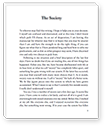Essay Instructions: ***PLEASE, ONLY EXPERIENCED LEGAL/CRIMINAL LAW WRITERS!! NO HOBBYIST!!***
State your positions and the reasons for it to each of the following 4 statements:
a. Explain the difference between the defenses of justification and excuses to criminal liability.
b. Explain why "insanity" is a legal concept and not a medical term.
c. When does insanity excuse criminal liability?
d. John Warnock Hinckley, Jr. (born May 29, 1955) attempted to assassinate U.S. President Ronald Reagan on March 30, 1981. Hinckley fired a Röhm RG-14 six times at Reagan as he left the Hilton Hotel in Washington, D.C. after addressing an AFL-CIO conference. The gun cost $25, was manufactured by Röhm Gesellschaft, a West German company, and assembled in Miami by its American subsidiary, R.G. Industries, Inc. ATF agents determined that the gun was bought at Rocky's Pawn Shop in Dallas, Texas. It was loaded with six Devastator rounds, designed to explode on impact, though all failed to do so. Hinckley wounded press secretary James Brady, police officer Thomas Delahanty, and Secret Service agent Timothy McCarthy. The initial barrage missed President Reagan, but he was seriously wounded when a bullet that ricocheted from the bulletproof glass of the presidential limousine hit him in the chest. Hinckley did not attempt to flee and was arrested at the scene. All of the shot men survived and recovered, although Brady, who had been shot in the right side of his head, remained paralyzed on the left side of his body. At the trial in 1982, charged with 13 offenses, Hinckley was found not guilty by reason of insanity on June 21. The defense psychiatric reports found him to be insane while the prosecution reports declared him legally sane.
----> Q: Under the defenses to criminal liability, was the verdict in the Hinckley case and his subsequent commitment to a mental hospital (rather than prison) a miscarriage of justice? Why or why not?
PLEASE FOLLOW THESE SPECIFIC INSTRUCTIONS:
(1) Don’t include an abstract.
(2) All essays MUST be supported with:
-----> strong empirical evidence (if & when necessary),
-----> specific, non-superficial references from acceptable sources cited, by expanding on & not simply a regurgitation of what's in the sources,
-----> a MINIMUM of 2 acceptable academic sources (see #3 below) that strengthen each essays’ argument, AND
-----> of course, STRONG concluding paragraph(s).
(3) Acceptable Academic References: SCHOLARLY SOURCES, such as peer-reviewed journal articles (on-line -- cited as "[Electronic version]" -- or hardcopy), U.S. Government publications (PDF format only – websites will not count), criminal law/criminal justice/criminal procedure textbook, etc.
(4) Direct Quotations: It's PREFERRED that the essay doesn't have any direct quotes from any of the references/sources used.
-----> HOWEVER, if a direct quote is necessary, a MAXIMUM of 3 direct quotes are allowed & each direct quote can be NO longer than 2 lines of written text.
-----> OTHERWISE, all work MUST be paraphrased OR in own words with proper APA citations.


